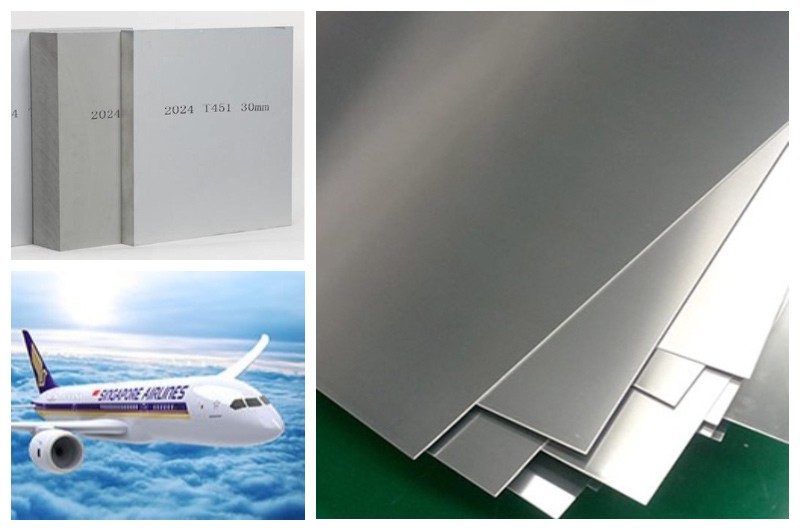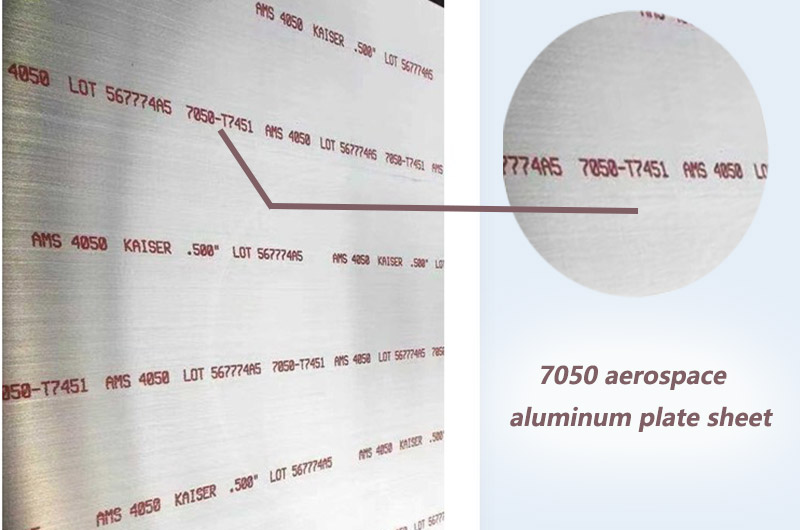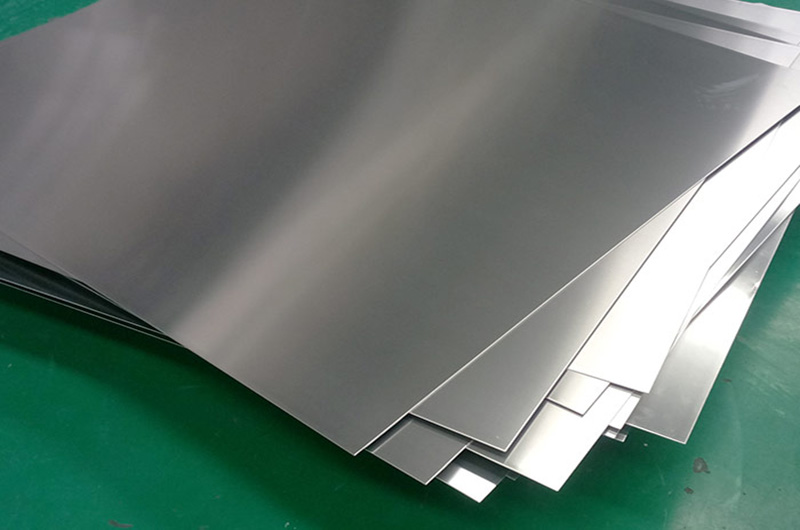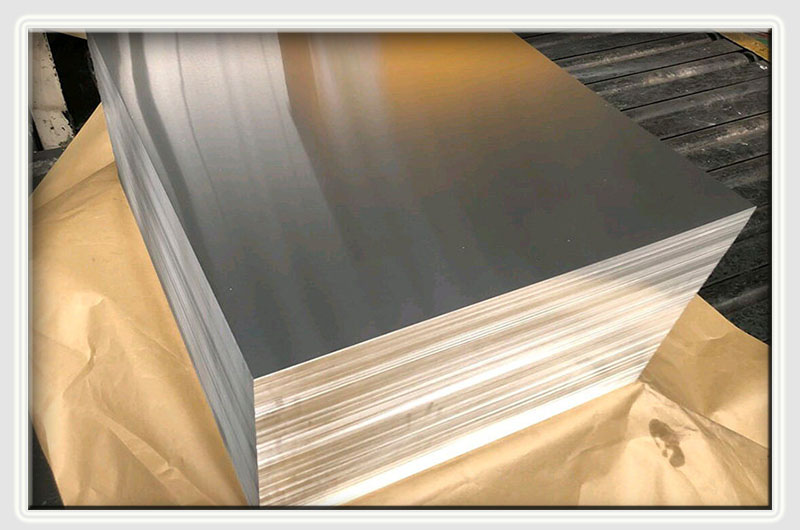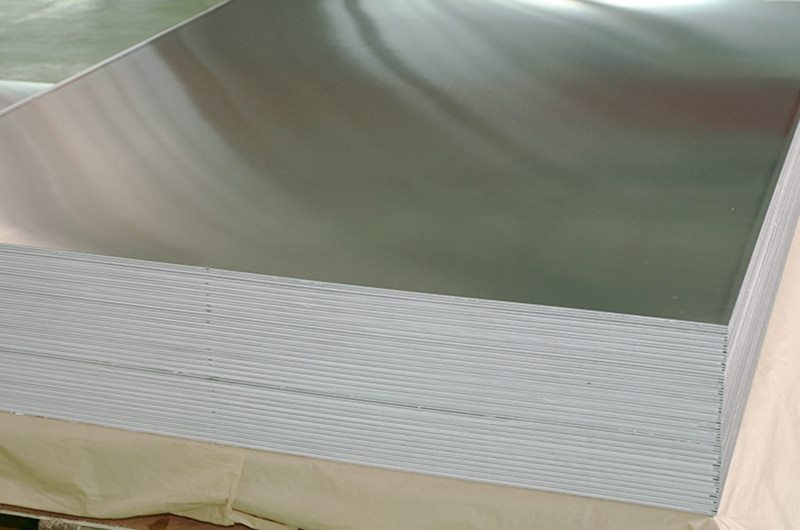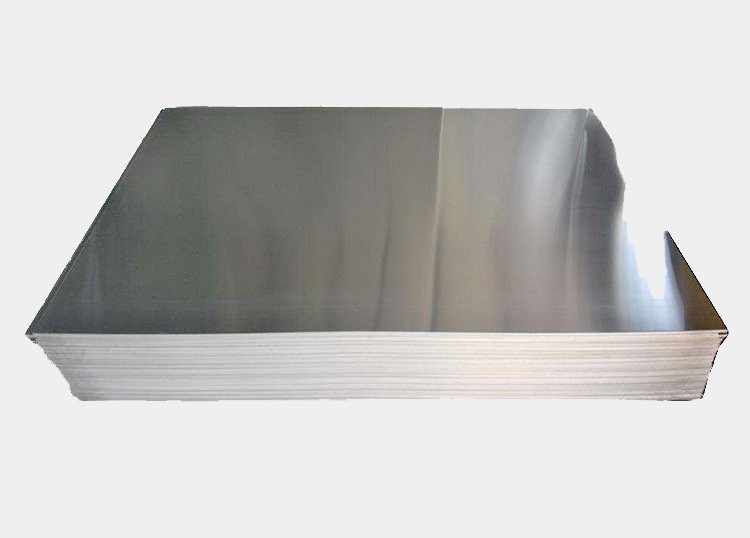- Advantages of 2219 Aerospace Aluminum Alloy Plate
- 2219 aerospace grade aluminum plate specifications
- Typical Mechanical Properties of 2219 Aerospace Aluminum Plate
- Strictly Control the Production of Aircraft Aluminum Plate
- Typical 2219 Aircraft Aluminum Plate
- 2219 Aerospace Aluminum Plate Applications
- Chemical Composition of 2219 Aluminum Plate
- 2219 Aerospace Aluminum Plate Trends
The development of 2219 aerospace aluminum plates, like other aerospace materials, has been driven by the need for lightweight, high-strength materials that can withstand the demanding conditions of aerospace applications.
2219 aluminum plate is an Al-Cu-Mn high-strength aluminum alloy. Its low-temperature properties (including the toughness of welded joints) also increase as the temperature decreases, and it has excellent high and low temperature mechanical properties.
- When 2219 alloy is used to manufacture liquid oxygen and liquid hydrogen containers, the reliability at liquid hydrogen temperature can be guaranteed according to the principle of room temperature strength standard testing.
- 2219 is used for high-temperature structural applications, suitable for structural parts and high-strength welding parts working at high temperatures of 315°C, such as space boosters and fuel tanks.
2219 aluminum alloy sheets are mainly used to produce aircraft fuselages, wings, tails, etc., and can also be used in aerospace vehicle tank structures.
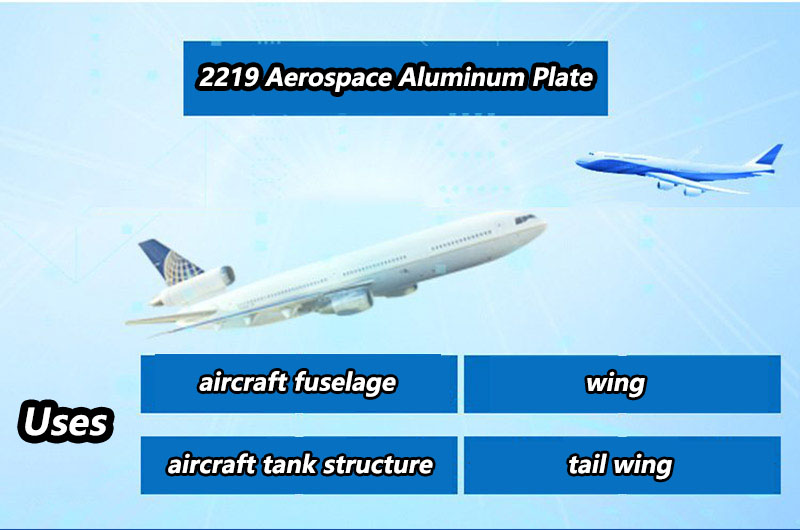
2219 aluminum alloy is a type of deformed aluminum in the United States. It has poor corrosion resistance and poor brazing performance, but has good machining performance, arc welding, and spot welding performance.
- In terms of stress corrosion cracking performance, 2219 alloy is better than 2014 alloy. The fuel tanks of American Thor-Deha and SatiimS-II are made of 2219 aluminum alloy.
- Compared with 2024 aircraft grade aluminum plate, 2219 aircraft grade aluminum plate has better heat resistance.
- In T8 condition, it resists stress corrosion cracking.
Due to its high strength and durability, 2219 aerospace aluminum sheet is often used in critical applications where safety and reliability are critical. However, it is important to note that aluminum alloys are prone to corrosion, so proper maintenance and protection must be done to ensure the longevity of aerospace components made from this material.

Advantages of 2219 Aerospace Aluminum Alloy Plate
| Advantage | Description |
| High Strength | The 2219 aluminum alloy sheet features a tensile strength of up to 540 MPa in its natural state, more than twice that of many other aluminum alloys, making it perfect for manufacturing high-strength structural parts and components. |
| Good Toughness | This alloy offers excellent toughness and ductility, remaining resilient even at low temperatures, which makes it suitable for use in low-temperature environments. |
| Excellent Welding Performance | The 2219 aluminum alloy plate is compatible with various common welding methods, including TIG, MIG, and resistance welding, ensuring versatility in processing and connection. |
| Corrosion Resistance | With copper elements enhancing its corrosion resistance, the 2219 aluminum alloy plate is suitable for various complex environments and climatic conditions, particularly resisting seawater and chemical corrosion. |
| High Temperature Resistance | This alloy maintains high strength and rigidity in high-temperature environments, functioning effectively within a temperature range of -253°C to 300°C. It's ideal for use in aero engines and rocket engines. |
| Fatigue Resistance | The 2219 aluminum alloy plate exhibits high resistance to fatigue cracking, ensuring excellent durability under long-term stress cycles. |
| Good Plasticity | The 2219 aluminum alloy plate offers good plasticity and formability, allowing it to be shaped through methods such as extrusion, rolling, and forging, facilitating the production of complex aluminum alloy components. |
| High Wear Resistance | Even in harsh working conditions involving high pressure, high speed, high temperature, and high impact, the 2219 aluminum alloy plate maintains good wear resistance. |
| High Machinability | This alloy is easy to cut and process, causing minimal wear on processing tools, which enhances production efficiency and reduces costs. |
Thanks to these exceptional properties, the 2219 aluminum alloy is widely used in aviation, aerospace, national defense, automotive, and machinery manufacturing industries, particularly in applications requiring high strength and high temperature resistance.
2219 aerospace grade aluminum plate specifications
- Level: 2219
- Status: T81, T87, O, T351
- Thickness: 0.3mm~300mm
- Standard size: 1250*2500mm, 1500*3000mm, 1525*3660mm
- Production standards: QQ-A-250/30
| Alloy | Temper | Thickness | Width |
|---|---|---|---|
| 2219 | T62 (MCS) | 4-260mm | 1200-3800mm |
| 2219 | T6 (CS) | 4-260mm | 1200-3800mm |
| 2219 | T87/C10S | 4-260mm | 1200-3800mm |
2219 aluminum suppliers usually offer the following types based on status: 2219 T6 aircraft grade aluminum, 2219-T851 aluminum plate, 2219-T87 aluminum plate, and 2219-T62 aluminum plate.
Typical Mechanical Properties of 2219 Aerospace Aluminum Plate
| Material | Temper | Thickness | Tensile Strength (ksi) | Yield Strength (ksi) | Elongation in 2" (%) |
| Alloy 2219 (QQ-A-250/30) | 0 | 0.020"-2.00 | 32 max | 16 max | 12 |
| Alloy 2219 (QQ-A-250/30) | T351 | 0.250"-2.00" | 46 | 28 | 10 |
| Alloy 2219 (QQ-A-250/30) | T851 | 0.250"-2.00" | 62 | 46 | 7-8 |
Strictly Control the Production of Aircraft Aluminum Plate
- Chemical Composition : 2219 Aluminum Sheet is manufactured to strict chemical purity standards to ensure consistent and reliable performance.
- Mechanical Properties : Mechanical properties, including strength, toughness and ductility meeting industry standards, are critical to their performance in aerospace applications.
- Surface Finish : The smooth, uniform surface of 2219 aluminum sheet is critical to its ability to be formed, machined and welded in aircraft manufacturing.
- CERTIFIED AND TESTED : Aluminum panels are AMS, QQ-A-250/30 certified and have a rigorous quality control program that ensures their 2219 aluminum panels meet industry standards for performance and reliability.
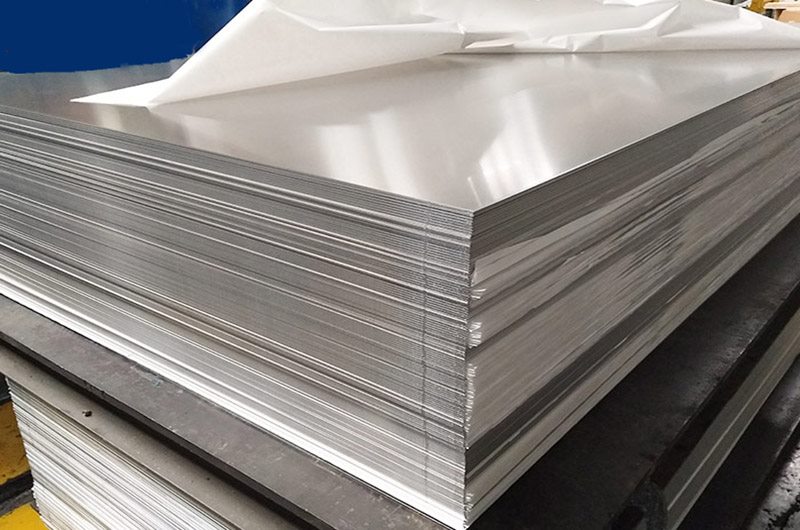
Typical 2219 Aircraft Aluminum Plate
2219 T6 Aircraft Aluminum Plate
The most common temper of 2219 T6 aluminum plate, is a solution heat treatment and artificial aging temper, which can provide good strength, toughness and resistance to stress corrosion cracking.
- Compared with T81 and T851, 2219 T6 has lower strength and toughness, but is more ductile and easier to form.
- 2219 T6 aluminum sheet is commonly used for fuselage frames, landing gear components and structural elements of aircraft or spacecraft.
2219 T81 Aircraft Aluminum Plate
2219 T81 aluminum plate is high-strength tempered through special solution heat treatment and aging process. It has excellent resistance to fatigue and crack growth, making it suitable for applications requiring high cyclic loading.
- 2219 T81 has higher strength and toughness than T6 and T851, but is less ductile and more difficult to form.
- 2219 T81 is typically used on wing skins and bulkheads where high cyclic load resistance is required.
2219 T851 Aircraft Aluminum Plate
2219 T851 is another high strength temper of 2219 aluminum plate with excellent resistance to fatigue and crack growth.
- 2219 T851 has higher strength and toughness than T6 and T81, but is less ductile and more difficult to form.
- 2219 T851 is typically used on wing skins and bulkheads where high cyclic load resistance is required.
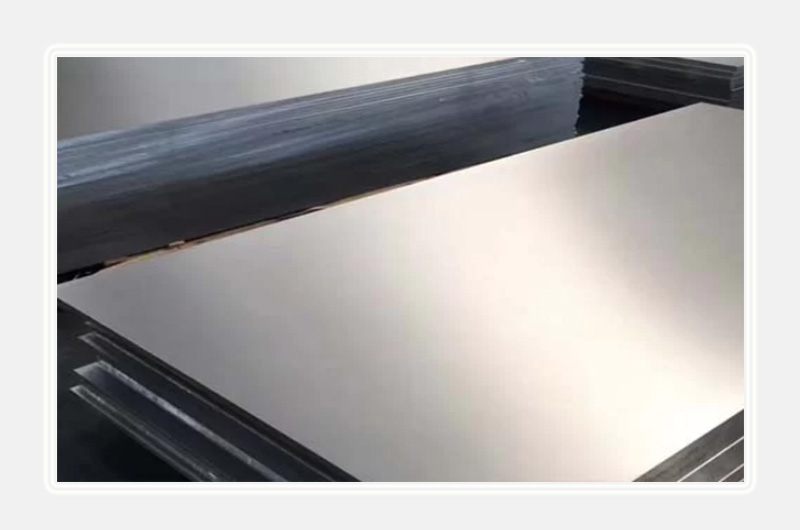
2219 O Aircraft Aluminum Plate
2219 O is the annealed state of 2219 aluminum sheet, which is soft and ductile.
2219 O is typically used in applications that require forming or shaping the material, such as forming into curved shapes for fuselage or wing components.
2219 Aerospace Aluminum Plate Applications
2219 aluminum is commonly used in the aerospace industry for the manufacture of structural parts and parts requiring high strength, toughness and fatigue resistance.
2219 T81 or T851 Aerospace Aluminum Plate for Aircraft Wing Skins
2219 aluminum is commonly used in the manufacture of wing skin, the outermost surface of an airfoil that provides lift and stability during flight.
- 2219 Aluminum is typically used in T81 or T851 tempers for wing skins.
- Using 2219 aluminum in wing skins reduces weight, improves fuel efficiency and improves aircraft performance.
- 2219 T81, T851 This high-strength temper provides excellent resistance to fatigue and crack growth, which is important for the outermost surfaces of airfoils that are subjected to high loads and stresses during flight.
2219 T62 Aerospace Aluminum Plate for Aircraft Fuel Tanks
Aircraft fuel tanks require excellent corrosion resistance to ensure the safe storage and delivery of fuel. For this reason, the 2219 aluminum alloy in the T62 temper is commonly used. This alloy and temper combination provides the necessary corrosion resistance and sealing performance to maintain fuel integrity under various conditions.
2219 O T351 T851 Aerospace Aluminum Plate for Fuselage Shell
The fuselage shell of an aircraft benefits significantly from the use of 2219 aluminum alloy in O, T351, or T851 tempers. This alloy is selected due to its high strength and good toughness, which are crucial for protecting the fuselage structure and ensuring the safety of both passengers and the aircraft itself. Typical thicknesses for fuselage shells range from 0.5 to 1.5 inches, depending on the specific requirements and design considerations.
2219 T851 Aerospace Aluminum Plate for Aircraft Wings
For the aircraft wings, the 2219 T851 aluminum plate is an excellent choice. The high strength and good toughness of this alloy allow it to withstand the significant weight and aerodynamic loads imposed on the wings. It ensures the structural integrity of the wings, which are critical components for flight. The typical thickness for wing structures can vary but generally falls between 0.75 to 2 inches.
2219 T6 Aerospace Aluminum for Aircraft Fuselage Frames
2219 aluminum is also used in the manufacture of fuselage frames, which form the structure of an aircraft's fuselage and provide support for other components such as wings, engines and landing gear.
- 2219 aluminum is commonly used for T6 tempering of fuselage frames.
- The fuselage frame is made of 2219 aluminum material, which improves the strength and durability, which can improve the overall safety and reliability of the aircraft.
- 2219 T6 This temper provides good strength and toughness, making it ideal for structural components that must support heavy loads and resist deformation.
2219 T81 or T851 Aerospace Aluminum Plate for Bulkheads
2219 aluminum is used for bulkheads, the structural components that divide the aircraft fuselage into compartments and provide support for flight loads.
- 2219 aluminum is commonly used in T81 or T851 tempers for bulkheads.
- The use of 2219 aluminum in bulkheads reduces weight, improves fuel efficiency and improves aircraft performance.
- 2219 T81, T851 These high strength tempers have excellent resistance to fatigue and crack growth, which is important for components that must withstand cyclic loads and stresses.
2219 T6 Aerospace Aluminum for Landing Gear Components
2219 aluminum is used to manufacture landing gear components such as struts and wheels, which must be able to withstand the high stresses and loads associated with takeoff, landing and taxiing.
- 2219 aluminum is typically used for the T6 temper of landing gear components such as struts and wheels.
- The use of 2219 aluminum in landing gear components increases durability and reliability, increasing aircraft safety.
- 2219 T6 This temper provides good strength and toughness, making it ideal for components that must withstand high stresses and loads during takeoff, landing and taxiing.
2219 T6 Aerospace Aluminum for Rocket and Spacecraft Components
2219 aluminum is also used in the manufacture of rocket and spacecraft components, such as fuel tanks and structural elements, due to its high strength, toughness, and corrosion resistance in the harsh space environment.
- 2219 aluminum is commonly used in T6 tempers for rocket and spacecraft components such as fuel tanks and structural elements.
- The use of 2219 aluminum in rocket and spacecraft components can reduce weight, improve fuel efficiency and improve spacecraft performance.
- 2219 T6 This temper provides good strength and toughness, making it ideal for components that must withstand the extreme temperatures and pressures of spaceflight.
Chemical Composition of 2219 Aluminum Plate
| ALLOY | SI | FE | CU | MN | MG | CR | ZN | ZR | TI | STANDARD |
| 2219 | 0.20 | 0.30 | 5.8-6.8 | 0.20-0.40 | 0.02 | - | 0.10 | 0.10-0.25 | 0.02-0.10 | GB/AMS/EN |
2219 Aerospace Aluminum Plate Trends
1. Lightweighting and Fuel Efficiency
The aerospace industry continues to prioritize lightweighting efforts to enhance fuel efficiency and reduce emissions. This trend underscores the importance of aluminum alloys like 2219 for their combination of strength and low density.
2. Sustainability
Environmental concerns are leading to greater interest in sustainable practices in the aerospace industry. Recycling of aluminum materials, including 2219, is becoming more important.
3. Advanced Manufacturing
Innovations in manufacturing techniques, including additive manufacturing (3D printing), are changing the way aerospace components are produced. These technologies can impact material requirements and part design.
4. Emerging Markets
The growth of aerospace markets in emerging economies, such as China and India, is contributing to increased demand for aerospace materials, including aluminum plates.
5. Space Industry
The expansion of the commercial space industry is creating new opportunities and driving demand for aerospace materials, including those used in spacecraft and launch vehicles.

